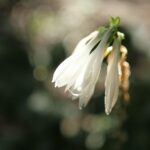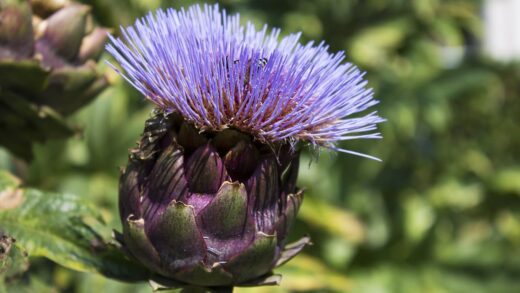The Jerusalem artichoke is widely celebrated for its robustness and general resistance to many of the common ailments that afflict other garden vegetables. This resilience makes it an attractive crop for low-maintenance and organic gardening systems. However, no plant is entirely immune to problems, and under certain conditions, Jerusalem artichokes can fall prey to a number of diseases and pests. Being aware of these potential issues, understanding the conditions that favor them, and knowing how to implement preventative and control measures is key to maintaining a healthy, productive patch year after year.
The most common diseases that affect Jerusalem artichokes are fungal in nature, and they are almost always exacerbated by unfavorable environmental conditions, particularly high humidity, poor air circulation, and wet soil. One of the most significant threats is Sclerotinia stem rot, also known as white mold, which can cause the entire plant to wilt and die. Other potential fungal issues include powdery mildew, which appears as a white, dusty coating on the leaves, and rust, which presents as reddish-brown pustules. The best defense against these diseases is prevention through smart cultural practices.
When it comes to pests, the Jerusalem artichoke is generally not a primary target for most common garden insects. Aphids may occasionally colonize the plants, especially on the tender new growth, but they rarely cause enough damage to warrant intervention, as natural predators often keep their populations in check. A more significant threat comes from below the ground. Slugs and snails can damage the emerging shoots in the spring, while various soil-dwelling grubs might feed on the developing tubers. The most destructive pests, however, tend to be vertebrate animals that are attracted to the nutritious tubers.
The key to managing these potential disease and pest problems lies in an integrated approach that prioritizes a healthy growing environment. This includes proper plant spacing to ensure good air circulation, choosing a planting site with well-drained soil to avoid waterlogged conditions, and practicing good garden hygiene, such as removing and disposing of infected plant material. By creating conditions that favor the plant’s natural vigor and discourage pathogens and pests, you can often avoid problems before they even start, ensuring your resilient crop lives up to its easy-to-grow reputation.
Common fungal diseases
Among the diseases that can affect Jerusalem artichokes, fungal pathogens are the most prevalent, with Sclerotinia stem rot (white mold) being one of the most serious. This disease is caused by the fungus Sclerotinia sclerotiorum and typically appears in mid to late summer, especially during cool, wet weather. The initial symptoms include water-soaked lesions on the stem, usually near the soil line. These lesions expand, girdling the stem and causing all parts of the plant above the lesion to suddenly wilt and die. A characteristic white, cottony fungal growth may be visible on the stem, and eventually, hard, black structures called sclerotia, which resemble mouse droppings, form within and on the affected tissues.
More articles on this topic
Powdery mildew is another common fungal issue that, while less destructive than stem rot, can still impact plant health. It is easily identified by the characteristic white to grayish, powdery patches that appear on the upper surfaces of the leaves, and sometimes on the stems. Unlike many other fungi, powdery mildew thrives in both humid and dry conditions and is often most prevalent in late summer and autumn. While a mild infection is largely cosmetic, a severe case can coat the leaves, inhibiting photosynthesis, which can lead to reduced plant vigor and potentially smaller tuber yields. It can also cause leaves to yellow and die prematurely.
Rust diseases, caused by various species of Puccinia fungi, can also occasionally appear on Jerusalem artichoke plants. The symptoms of rust are small, reddish-brown pustules that erupt on the undersides of the leaves. These pustules contain powdery spores that can be spread by the wind to infect other plants. In severe infections, the leaves may turn yellow and dry up, falling from the plant early. As with powdery mildew, rust can reduce the plant’s photosynthetic capacity, which, if it occurs early enough in the season, can negatively affect the final size of the tubers.
The most effective strategy for managing these fungal diseases is prevention. Ensure proper spacing between plants (at least 30-45 cm apart) to promote good air circulation, which helps leaves dry quickly after rain. Water the soil at the base of the plants rather than using overhead sprinklers to keep the foliage as dry as possible. At the end of the season, remove and destroy all plant debris, as fungi like Sclerotinia can survive the winter on dead plant material. For Sclerotinia in particular, crop rotation is crucial; avoid planting Jerusalem artichokes or other susceptible crops like sunflowers, beans, or lettuce in the same spot for at least two to three years if the disease has been present.
Managing common pests
While Jerusalem artichokes are not a magnet for pests, there are a few common garden inhabitants that can cause damage, particularly during specific stages of the plant’s growth. In the early spring, as the tender new shoots are emerging from the soil, slugs and snails can be a significant problem. These mollusks are attracted to the soft, succulent growth and can chew off the shoots at ground level, which can kill the young plant. To manage them, you can employ various strategies such as hand-picking them at night, setting up beer traps, or creating a barrier of coarse material like crushed eggshells or diatomaceous earth around the base of the plants.
More articles on this topic
Aphids are another common pest that may be found on Jerusalem artichokes, typically clustering on the undersides of leaves or on the tender tips of new growth. They feed by sucking sap from the plant, and while a large infestation can cause some leaf curling and distortion, they rarely pose a serious threat to the overall health of these vigorous plants. In most garden ecosystems, natural predators such as ladybugs, lacewings, and hoverflies will quickly arrive to control the aphid population. It is often best to tolerate a small number of aphids to support these beneficial insects, and only intervene with a strong spray of water from a hose if the numbers become excessive.
The most significant pest pressure for Jerusalem artichokes often comes from below the ground, targeting the valuable tubers. Various types of soil-dwelling larvae, such as the grubs of chafer beetles, can chew holes in the developing tubers. However, the most destructive pests are often vertebrate animals. Voles, which are small, mouse-like rodents, can create extensive tunnel systems underground and consume a large portion of the crop directly from the soil. Their presence is often indicated by disappearing plants and networks of tunnels just below the soil surface.
Managing these vertebrate pests requires a different approach. For burrowing rodents like voles, strategies can include setting traps in their runways or encouraging natural predators like owls and hawks by installing perches. A proactive and highly effective method is to create a physical barrier by lining the planting bed with a sturdy hardware cloth or wire mesh before planting, which prevents the animals from accessing the tubers from below. For larger animals like deer, who may browse the foliage, or squirrels and rabbits, who may dig up tubers, a tall and sturdy fence around the garden patch is often the most reliable solution.
Integrated pest management strategies
Integrated Pest Management (IPM) is a holistic and sustainable approach to dealing with pests and diseases that is perfectly suited for growing a resilient crop like Jerusalem artichokes. The foundation of IPM is prevention. This starts with creating a healthy, stress-free growing environment for the plants, as healthy plants are naturally more resistant to problems. This includes preparing fertile, well-drained soil, providing adequate sunlight, and ensuring proper spacing between plants to promote good air circulation. A strong, vigorous plant is the first line of defense against any potential pest or disease outbreak.
A key component of IPM is regular monitoring of your plants. Make it a habit to walk through your Jerusalem artichoke patch every few days and inspect the leaves, stems, and surrounding soil. Look for any early signs of trouble, such as leaf discoloration, wilting, the presence of insects, or the tell-tale slime trails of slugs. Catching a problem early, when it is just beginning, makes it far easier to manage than waiting until a full-blown infestation or infection has taken hold. Early detection allows for targeted, minimal interventions rather than broad, reactive treatments.
IPM emphasizes the use of biological and cultural controls as the primary methods of management. This means encouraging natural predators in your garden. For example, by planting a diversity of flowering plants, you can attract beneficial insects like ladybugs and lacewings that prey on aphids. Cultural controls involve your gardening practices, such as rotating your crop to a new location every few years to prevent the buildup of soil-borne diseases like Sclerotinia stem rot. It also includes good sanitation, such as removing and destroying any diseased plant material promptly and cleaning up all plant debris at the end of the season.
Chemical controls, even organic ones, are used in an IPM framework only as a last resort, when monitoring indicates that a pest or disease problem is reaching a level that will cause unacceptable damage. If treatment is necessary, the least toxic option should be chosen and applied in a targeted manner to minimize harm to beneficial organisms and the wider environment. For Jerusalem artichokes, it is rare that chemical intervention is ever needed. By focusing on the preventative and cultural strategies of IPM, you can maintain a healthy and productive patch using entirely natural and sustainable methods.
Preventing future outbreaks
Preventing future outbreaks of diseases and pests in your Jerusalem artichoke patch relies on a proactive, long-term management strategy that begins as soon as the current season’s harvest is over. The most critical step is rigorous garden sanitation. After cutting down the stalks, it is essential to remove all plant debris from the area, including stalks, leaves, and any rotten or diseased tubers you find. Pathogens like the fungus that causes Sclerotinia stem rot can survive the winter in this debris, creating a source of infection for the following year. Do not add diseased plant material to your home compost pile; it should be burned (where permitted) or disposed of in the trash.
Crop rotation is a cornerstone of disease prevention, particularly for soil-borne pathogens. If you have experienced significant disease problems, especially Sclerotinia stem rot, it is crucial not to replant Jerusalem artichokes in the same location for at least three to four years. This rotation breaks the life cycle of the disease, as the pathogen’s resting bodies (sclerotia) in the soil will eventually die off without a suitable host plant. When you rotate, choose a new site with good drainage and sunlight, and plant a crop from a different plant family, such as grains or corn, that is not susceptible to the same diseases.
Building and maintaining healthy soil is another key preventative measure. Soil rich in organic matter and teeming with beneficial microbes can help to suppress disease-causing organisms. Annually amending the bed with a generous layer of high-quality compost not only provides nutrients for the plants but also fosters a competitive soil environment where pathogens struggle to gain a foothold. Healthy soil grows healthy plants, and healthy, vigorous plants are inherently more capable of resisting and recovering from pest and disease attacks.
Finally, when you do replant or allow your patch to regrow, be mindful of your plant stock. If you are saving your own tubers for replanting, be meticulously selective. Choose only the healthiest, blemish-free tubers from robust, disease-free plants. Never replant tubers that show any signs of rot, softness, or strange discolorations. If you are sourcing new tubers, purchase them from a reputable supplier to ensure you are starting with certified disease-free stock. By combining these strategies of sanitation, rotation, soil health, and clean planting material, you can significantly reduce the likelihood of future outbreaks.


















